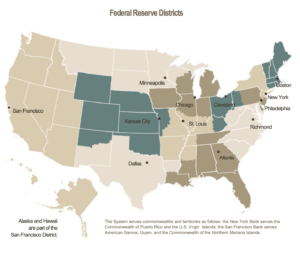Congress has quickly engaged in putting together potential aid packages for farmers that would more than double the Trump administration's $12 billion under the Farmer Bridge Assistance (FBA) Program.
Federal Reserve: Observations on the Ag Economy- October 2023
On Wednesday, the Federal Reserve Board released its October 2023 Beige Book update, a summary of commentary on current economic conditions by Federal Reserve District. The report included several observations pertaining to the U.S. agricultural economy.

* Sixth District- Atlanta– “Agriculture conditions were mixed. Demand for butter increased, but there remained an excess supply of cheese products. In Louisiana and Mississippi, droughts led to the liquidation of herds, resulting in an oversupply of beef. Chicken exports were weak. Soybean and corn yields were strong, creating surpluses. Domestic cotton yields were high, but demand for textiles softened. Hurricane Idalia hit Florida’s ‘timber basket,’ causing farmers to give away downed trees or pay to have them removed, dampening sales of timber.”
* Seventh District- Chicago–
Projected farm income in the District for 2023 remained well below 2022 levels, as lower crop prices offset positive news from early harvested acres.
“Notably, corn and soybean prices continued to fall, while yields were coming in above earlier expectations, which had been pessimistic due to the ongoing drought. Cattle prices moved higher, but growth slowed some. That said, one contact reported that with the exception of beef, many animal operations were experiencing below breakeven prices. Egg prices were flat, while dairy prices were mostly higher. Prices for agricultural land showed signs of softening, especially for ground of lesser quality. Rising interest rates stretched farm finances given high debt levels of many operators.”
* Eighth District- St. Louis– “Overall agricultural activity has remained stable since our previous report, though contacts’ outlook for future conditions was mixed. Corn and cotton yields across the District fell slightly below 2022 levels, while rice and soybean yields hovered slightly above. Corn and rice production increased relative to this time last year, but cotton and soybeans decreased.
Low water levels meant that barges needed to float at a lower weight, which raised shipping costs.
“Due to elevated storage and transport costs, some contacts stated they planned to leave their crop in the field rather than harvest.”
* Ninth District- Minneapolis– “District agricultural conditions strengthened slightly since the previous report. Drought conditions moderated in parts of the District but persisted in the eastern and northern regions. Industry contacts reported that early indications of crop production were better than expected, given weather conditions. However, farm incomes decreased from a year earlier in the third quarter, according to preliminary results of the Minneapolis Fed’s survey of agricultural credit conditions.”
* Tenth District- Kansas City– “Conditions in the Tenth District farm economy softened alongside further declines in commodity prices and prolonged drought. As harvest began in some areas, at least one third of corn and soybean acres were in very poor condition, raising concerns about yields and revenue.
Dry conditions across the nation also reduced water levels in the Mississippi River, disrupting barge traffic along many gulf port routes and heightening concerns about freight costs and export activity.
“Cattle prices continued to be supported by low inventories, but drought also constrained hay supply in many areas, raising costs for ranchers. Interest rates were another key concern cited by agricultural contacts, as producers faced significantly higher financing costs.”
* Eleventh District- Dallas– “Drought intensified across much of the District over the past six weeks and crops continued to suffer from excessive heat. Grain prices fell notably, with wheat hitting its lowest price in two years. Pasture forage conditions were poor to very poor, and ranchers were still supplemental feeding, which is unusual for this time of year. Cattle prices remained high amid tighter supply, cheaper production costs in feed lots, and strong demand for beef.”
* Twelfth District- San Francisco– “Conditions in the agriculture and resource-related sectors strengthened slightly overall. Growers reported strong demand for fruits, vegetables, and cotton, as well as steady demand for nuts. Inventories from prior harvests bolstered supply, and the upcoming harvest season is expected to produce large yields. Production at fisheries was stable. Overall exports of agricultural proucts softened somewhat due to a strong dollar and weaker growth abroad. While input costs remained generally elevated, increased water availability from higher rain and snowfall helped reduce the costs of irrigation. Nonetheless, severe weather events had negative impacts on the production of some food crops, including grapes. Producers expressed concern about the ramifications of geopolitical and extreme weather events on future food availability.”





